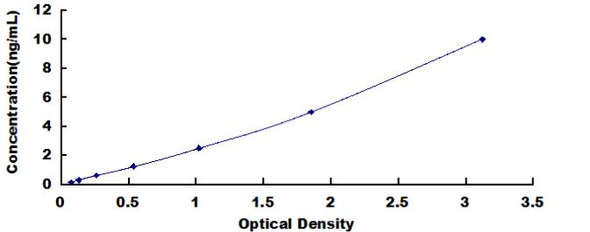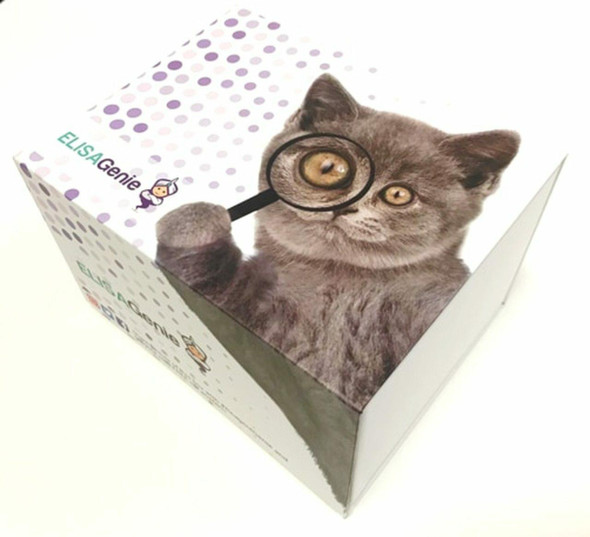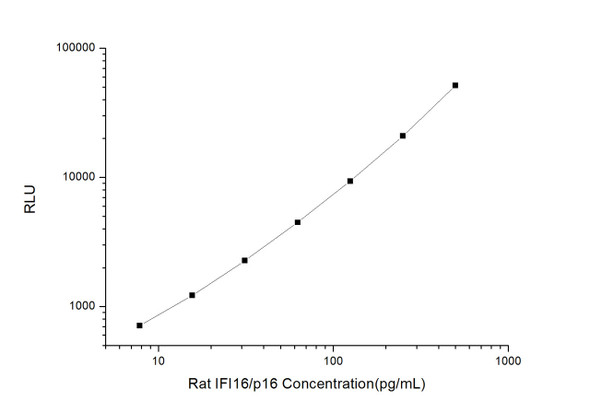Human Gamma-interferon-inducible protein 16 (IFI16) ELISA Kit (HUEB2022)
- SKU:
- HUEB2022
- Product Type:
- ELISA Kit
- Size:
- 96 Assays
- Uniprot:
- Q16666
- Range:
- 0.156-10 ng/mL
- ELISA Type:
- Sandwich
- Synonyms:
- IFI16, amma-interferon-inducible protein 16, Ifi-16, Interferon-inducible myeloid differentiation transcriptional activator, IFNGIP1, PYHIN2
- Reactivity:
- Human
Description
Human Gamma-interferon-inducible protein 16 (IFI16) ELISA Kit
The Human Gamma Interferon-Inducible Protein 16 (IFI16) ELISA Kit is a powerful tool for detecting levels of IFI16 in human samples including serum, plasma, and cell culture supernatants. With its high sensitivity and specificity, this kit delivers dependable and consistent results, making it highly suitable for a variety of research applications.IFI16 is a key protein involved in the immune response, particularly in the regulation of interferon gamma signaling.
Its role in various diseases such as autoimmune disorders, inflammatory conditions, and viral infections makes it a valuable biomarker for studying these diseases and exploring potential therapeutic interventions.Overall, the Human Gamma Interferon-Inducible Protein 16 (IFI16) ELISA Kit is a crucial resource for researchers aiming to delve deeper into the mechanisms of immune response and disease pathology.
| Product Name: | Human Gamma-interferon-inducible protein 16 (IFI16) ELISA Kit |
| SKU: | HUEB2022 |
| Size: | 96T |
| Target: | Human Gamma-interferon-inducible protein 16 (IFI16) |
| Synonyms: | Interferon-inducible myeloid differentiation transcriptional activator, Ifi-16, IFNGIP1 |
| Assay Type: | Sandwich |
| Detection Method: | ELISA |
| Reactivity: | Human |
| Detection Range: | 0.156-10ng/mL |
| Sensitivity: | 0.078ng/mL |
| Intra CV: | 5.3% | ||||||||||||||||||||
| Inter CV: | 10.3% | ||||||||||||||||||||
| Linearity: |
| ||||||||||||||||||||
| Recovery: |
| ||||||||||||||||||||
| Function: | Binds double-stranded DNA. Binds preferentially to supercoiled DNA and cruciform DNA structures. Seems to be involved in transcriptional regulation. May function as a transcriptional repressor. Could have a role in the regulation of hematopoietic differentiation through activation of unknown target genes. Controls cellular proliferation by modulating the functions of cell cycle regulatory factors including p53/TP53 and the retinoblastoma protein. May be involved in TP53-mediated transcriptional activation by enhancing TP53 sequence-specific DNA binding and modulating TP53 phosphorylation status. Seems to be involved in energy-level-dependent activation of the ATM/ AMPK/TP53 pathway coupled to regulation of autophagy. May be involved in regulation of TP53-mediated cell death also involving BRCA1. May be involved in the senescence of prostate epithelial cells. Involved in innate immune response by recognizing viral dsDNA in the cytosol and probably in the nucleus. After binding to viral DNA in the cytoplasm recruits TMEM173/STING and mediates the induction of IFN-beta. Has anti-inflammatory activity and inhibits the activation of the AIM2 inflammasome, probably via association with AIM2. Proposed to bind viral DNA in the nucleus, such as of Kaposi's sarcoma-associated herpesvirus, and to induce the formation of nuclear caspase-1-activating inflammasome formation via association with PYCARD. Inhibits replication of herpesviruses such as human cytomegalovirus (HCMV) probably by interfering with promoter recruitment of members of the Sp1 family of transcription factors. Necessary to activate the IRF3 signaling cascade during human herpes simplex virus 1 (HHV-1) infection and promotes the assembly of heterochromatin on herpesviral DNA and inhibition of viral immediate-early gene expression and replication. Involved in the MTA1-mediated epigenetic regulation of ESR1 expression in breast cancer. |
| Uniprot: | Q16666 |
| Sample Type: | Serum, plasma, tissue homogenates, cell culture supernates and other biological fluids |
| Specificity: | Natural and recombinant human Gamma-interferon-inducible protein 16 |
| Sub Unit: | Forms homooligomers; isoform 2 can self-associate or associate with isoform 1 or isoform 3. Interacts with TMEM173, AIM2, PYCARD and CASP1. Interacts with BRCA1, TP53, E2F1, RB1 and SP1. Interacts with MTA1. |
| Research Area: | Cancer |
| Subcellular Location: | Nucleus Cytoplasm Cellular distribution is dependent on the acetylation status of the multipartite nuclear localization signal (NLS); NLS acetylation promotes cytoplasmic localization. Localizes in the nucleus during human herpes simplex virus 1 (HHV-1) infection. |
| Storage: | Please see kit components below for exact storage details |
| Note: | For research use only |
| UniProt Protein Function: | IFI16: a nuclear protein that may function as a transcriptional repressor. Strongly induced by gamma interferon and, to a lesser extent, by alpha interferon. Binds double-stranded DNA and cell cycle regulatory factors including p53 and Rb. Loss of IFI16 activates p53 checkpoint through NBS1-DNAPK pathway. Inhibits cell growth in the Ras/Raf signaling pathway. May be involved in the senescence of prostate epithelial cells. Expressed in peripheral blood leukocytes, fibroblasts and lymphoid cells. Present in myeloid precursors (CD34+) and throughout monocyte development, but its expression is down-regulated in erythroid and polymorphonuclear precursor cells. Present in prostate, ovary and breast. Four alternatively spliced isoforms have been described. Isoforms-1, -2 and -3 can homo- and hetero-dimerize. |
| UniProt Protein Details: | Protein type:Transcription factor Chromosomal Location of Human Ortholog: 1q22 Cellular Component: nucleoplasm; membrane; cytoplasm; nucleolus; nuclear speck; cytosol; nucleus Molecular Function:identical protein binding; protein binding; double-stranded DNA binding; transcription factor binding Biological Process: positive regulation of cytokine production; transcription, DNA-dependent; monocyte differentiation; negative regulation of transcription from RNA polymerase II promoter; regulation of gene expression, epigenetic; negative regulation of DNA binding; cellular response to glucose starvation; positive regulation of interleukin-1 beta production; cell proliferation; negative regulation of viral genome replication; negative regulation of innate immune response; positive regulation of interferon type I production; autophagy; innate immune response; hemopoiesis; positive regulation of transcription from RNA polymerase II promoter; myeloid cell differentiation; regulation of autophagy; negative regulation of transcription, DNA-dependent; inflammatory response; defense response to virus; activation of innate immune response; DNA damage response, signal transduction by p53 class mediator resulting in induction of apoptosis |
| NCBI Summary: | This gene encodes a member of the HIN-200 (hematopoietic interferon-inducible nuclear antigens with 200 amino acid repeats) family of cytokines. The encoded protein contains domains involved in DNA binding, transcriptional regulation, and protein-protein interactions. The protein localizes to the nucleoplasm and nucleoli, and interacts with p53 and retinoblastoma-1. It modulates p53 function, and inhibits cell growth in the Ras/Raf signaling pathway. Alternatively spliced transcript variants encoding different isoforms have been found for this gene. [provided by RefSeq, Apr 2011] |
| UniProt Code: | Q16666 |
| NCBI GenInfo Identifier: | 118572657 |
| NCBI Gene ID: | 3428 |
| NCBI Accession: | Q16666.3 |
| UniProt Secondary Accession: | Q16666,Q59GX0, Q5T3W7, Q5T3W8, Q5T3X0, Q5T3X1, Q5T3X2 Q8N9E5, Q8NEQ7, Q96AJ5, B4DJT8, H3BLV7, |
| UniProt Related Accession: | Q16666 |
| Molecular Weight: | 785 |
| NCBI Full Name: | Gamma-interferon-inducible protein 16 |
| NCBI Synonym Full Names: | interferon, gamma-inducible protein 16 |
| NCBI Official Symbol: | IFI16 |
| NCBI Official Synonym Symbols: | PYHIN2; IFNGIP1 |
| NCBI Protein Information: | gamma-interferon-inducible protein 16; interferon-gamma induced protein IFI 16; interferon-inducible myeloid differentiation transcriptional activator |
| UniProt Protein Name: | Gamma-interferon-inducible protein 16 |
| UniProt Synonym Protein Names: | Interferon-inducible myeloid differentiation transcriptional activator |
| Protein Family: | Gamma-interferon-inducible protein |
| UniProt Gene Name: | IFI16 |
| UniProt Entry Name: | IF16_HUMAN |
| Component | Quantity (96 Assays) | Storage |
| ELISA Microplate (Dismountable) | 8×12 strips | -20°C |
| Lyophilized Standard | 2 | -20°C |
| Sample Diluent | 20ml | -20°C |
| Assay Diluent A | 10mL | -20°C |
| Assay Diluent B | 10mL | -20°C |
| Detection Reagent A | 120µL | -20°C |
| Detection Reagent B | 120µL | -20°C |
| Wash Buffer | 30mL | 4°C |
| Substrate | 10mL | 4°C |
| Stop Solution | 10mL | 4°C |
| Plate Sealer | 5 | - |
Other materials and equipment required:
- Microplate reader with 450 nm wavelength filter
- Multichannel Pipette, Pipette, microcentrifuge tubes and disposable pipette tips
- Incubator
- Deionized or distilled water
- Absorbent paper
- Buffer resevoir
*Note: The below protocol is a sample protocol. Protocols are specific to each batch/lot. For the correct instructions please follow the protocol included in your kit.
Allow all reagents to reach room temperature (Please do not dissolve the reagents at 37°C directly). All the reagents should be mixed thoroughly by gently swirling before pipetting. Avoid foaming. Keep appropriate numbers of strips for 1 experiment and remove extra strips from microtiter plate. Removed strips should be resealed and stored at -20°C until the kits expiry date. Prepare all reagents, working standards and samples as directed in the previous sections. Please predict the concentration before assaying. If values for these are not within the range of the standard curve, users must determine the optimal sample dilutions for their experiments. We recommend running all samples in duplicate.
| Step | |
| 1. | Add Sample: Add 100µL of Standard, Blank, or Sample per well. The blank well is added with Sample diluent. Solutions are added to the bottom of micro ELISA plate well, avoid inside wall touching and foaming as possible. Mix it gently. Cover the plate with sealer we provided. Incubate for 120 minutes at 37°C. |
| 2. | Remove the liquid from each well, don't wash. Add 100µL of Detection Reagent A working solution to each well. Cover with the Plate sealer. Gently tap the plate to ensure thorough mixing. Incubate for 1 hour at 37°C. Note: if Detection Reagent A appears cloudy warm to room temperature until solution is uniform. |
| 3. | Aspirate each well and wash, repeating the process three times. Wash by filling each well with Wash Buffer (approximately 400µL) (a squirt bottle, multi-channel pipette,manifold dispenser or automated washer are needed). Complete removal of liquid at each step is essential. After the last wash, completely remove remaining Wash Buffer by aspirating or decanting. Invert the plate and pat it against thick clean absorbent paper. |
| 4. | Add 100µL of Detection Reagent B working solution to each well. Cover with the Plate sealer. Incubate for 60 minutes at 37°C. |
| 5. | Repeat the wash process for five times as conducted in step 3. |
| 6. | Add 90µL of Substrate Solution to each well. Cover with a new Plate sealer and incubate for 10-20 minutes at 37°C. Protect the plate from light. The reaction time can be shortened or extended according to the actual color change, but this should not exceed more than 30 minutes. When apparent gradient appears in standard wells, user should terminatethe reaction. |
| 7. | Add 50µL of Stop Solution to each well. If color change does not appear uniform, gently tap the plate to ensure thorough mixing. |
| 8. | Determine the optical density (OD value) of each well at once, using a micro-plate reader set to 450 nm. User should open the micro-plate reader in advance, preheat the instrument, and set the testing parameters. |
| 9. | After experiment, store all reagents according to the specified storage temperature respectively until their expiry. |
When carrying out an ELISA assay it is important to prepare your samples in order to achieve the best possible results. Below we have a list of procedures for the preparation of samples for different sample types.
| Sample Type | Protocol |
| Serum | If using serum separator tubes, allow samples to clot for 30 minutes at room temperature. Centrifuge for 10 minutes at 1,000x g. Collect the serum fraction and assay promptly or aliquot and store the samples at -80°C. Avoid multiple freeze-thaw cycles. If serum separator tubes are not being used, allow samples to clot overnight at 2-8°C. Centrifuge for 10 minutes at 1,000x g. Remove serum and assay promptly or aliquot and store the samples at -80°C. Avoid multiple freeze-thaw cycles. |
| Plasma | Collect plasma using EDTA or heparin as an anticoagulant. Centrifuge samples at 4°C for 15 mins at 1000 × g within 30 mins of collection. Collect the plasma fraction and assay promptly or aliquot and store the samples at -80°C. Avoid multiple freeze-thaw cycles. Note: Over haemolysed samples are not suitable for use with this kit. |
| Urine & Cerebrospinal Fluid | Collect the urine (mid-stream) in a sterile container, centrifuge for 20 mins at 2000-3000 rpm. Remove supernatant and assay immediately. If any precipitation is detected, repeat the centrifugation step. A similar protocol can be used for cerebrospinal fluid. |
| Cell culture supernatant | Collect the cell culture media by pipette, followed by centrifugation at 4°C for 20 mins at 1500 rpm. Collect the clear supernatant and assay immediately. |
| Cell lysates | Solubilize cells in lysis buffer and allow to sit on ice for 30 minutes. Centrifuge tubes at 14,000 x g for 5 minutes to remove insoluble material. Aliquot the supernatant into a new tube and discard the remaining whole cell extract. Quantify total protein concentration using a total protein assay. Assay immediately or aliquot and store at ≤ -20 °C. |
| Tissue homogenates | The preparation of tissue homogenates will vary depending upon tissue type. Rinse tissue with 1X PBS to remove excess blood & homogenize in 20ml of 1X PBS (including protease inhibitors) and store overnight at ≤ -20°C. Two freeze-thaw cycles are required to break the cell membranes. To further disrupt the cell membranes you can sonicate the samples. Centrifuge homogenates for 5 mins at 5000xg. Remove the supernatant and assay immediately or aliquot and store at -20°C or -80°C. |
| Tissue lysates | Rinse tissue with PBS, cut into 1-2 mm pieces, and homogenize with a tissue homogenizer in PBS. Add an equal volume of RIPA buffer containing protease inhibitors and lyse tissues at room temperature for 30 minutes with gentle agitation. Centrifuge to remove debris. Quantify total protein concentration using a total protein assay. Assay immediately or aliquot and store at ≤ -20 °C. |
| Breast Milk | Collect milk samples and centrifuge at 10,000 x g for 60 min at 4°C. Aliquot the supernatant and assay. For long term use, store samples at -80°C. Minimize freeze/thaw cycles. |










